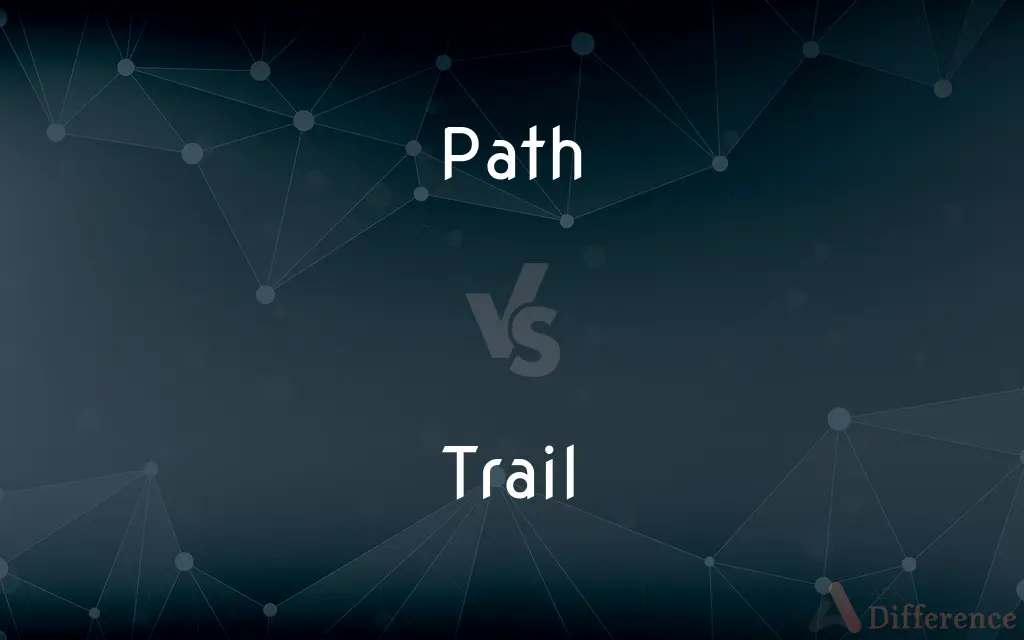Path vs. Trail — What's the Difference?
By Fiza Rafique & Maham Liaqat — Updated on April 18, 2024
Path refers to a narrow way designed for walking or cycling, often simple and unpaved, while a trail is generally used for hiking and is usually rough and natural.

Difference Between Path and Trail
Table of Contents
ADVERTISEMENT
Key Differences
A path is typically a small, narrow route that can be paved or unpaved and is designed primarily for pedestrians and sometimes cyclists. It is often found in urban or garden settings. On the other hand, a trail is usually an unpaved route that is more rugged and natural, commonly found in rural or wilderness areas and designed for hiking, walking, or even horseback riding.
Paths are often constructed with accessibility in mind, featuring flat and smooth surfaces that facilitate easy walking or riding. Whereas trails may navigate more challenging terrains, including mountains, forests, and other rough landscapes, often requiring more effort to traverse.
The purpose of a path is typically to connect points of interest within relatively short distances, such as within a park or between neighborhoods. Conversely, trails are often meant for recreational activities such as hiking or mountain biking, offering longer routes that encourage exploration and enjoyment of the natural environment.
Maintenance of paths is usually regular and managed by municipal authorities, ensuring they are clear of obstacles and safe for everyday use. On the other hand, trails might not be maintained as frequently, preserving a more natural state that can include natural obstacles like fallen trees or rocky passages.
In terms of signage, paths are generally well-marked, with clear indications of directions, distances, and points of interest. Trails, however, might have minimal signage to maintain a sense of adventure and exploration, with markers primarily at trailheads or critical junctions.
ADVERTISEMENT
Comparison Chart
Surface
Often paved and smooth
Typically unpaved and rugged
Location
Urban areas, gardens, parks
Rural areas, wilderness, mountains
Purpose
Connectivity, ease of access
Recreation, adventure
Maintenance
Regularly maintained by local authorities
Less frequently maintained, more natural
Signage
Well-marked with directional and informational signs
Minimal signage, focuses on natural exploration
Compare with Definitions
Path
A route or track between one place and another.
The garden path leads directly to the rose beds.
Trail
A path through a countryside, mountain, or forest area, often used for hiking.
The mountain trail was challenging but rewarding.
Path
A course of action or a way of achieving a specified result.
He chose the path of university to advance his career.
Trail
A mark or a series of signs or objects left behind by the passage of someone or something.
The hunter followed the deer's trail.
Path
A way or track laid down for walking or made by continual treading.
The worn path shows it's popular with joggers.
Trail
A route followed for a particular purpose.
The documentary crew blazed a trail into the jungle.
Path
A sequence of nodes along edges in a graph.
The algorithm finds the shortest path from point A to point B.
Trail
A beaten path through rough country such as a forest or moor.
The old forest trail is overgrown and wild.
Path
A paved walkway, especially in a park or garden.
We strolled down the winding park path in the evening.
Trail
A series of public vehicular routes on land.
The scenic trail is popular among cross-country motorcyclists.
Path
A way or track laid down for walking or made by continual treading
The path continues alongside the river for half a mile
Trail
A trail is usually a path, track or unpaved lane or road. In the United Kingdom and the Republic of Ireland, path or footpath is the preferred term for a walking trail.
Path
(chiefly in computing and railway contexts) allocate a path.
Trail
To allow to drag or stream behind, as along the ground
The dog ran off, trailing its leash.
Path
A trodden track or way.
Trail
To drag (the body, for example) wearily or heavily.
Path
A road, way, or track made for a particular purpose
A bicycle path.
Trail
To follow the traces or scent of, as in hunting; track.
Path
The route or course along which something travels or moves
The path of a hurricane.
Trail
To follow the course taken by; pursue
Trail a fugitive.
Path
A course of action or conduct
The path of righteousness.
Trail
To follow behind
Several cruisers trailed by an escorting destroyer.
Path
A sequence of commands or a link between points that is needed to reach a particular goal.
Trail
To lag behind (an opponent)
Trailed the league leader by four games.
Path
A pathname.
Trail
To drag or be dragged along, brushing the ground
The queen's long robe trailed behind.
Path
A trail for the use of, or worn by, pedestrians.
Trail
To extend, grow, or droop loosely over a surface
Vines trailing through the garden.
Path
A course taken.
The path of a meteor, of a caravan, or of a storm
Trail
To drift in a thin stream
Smoke trailing from a dying fire.
Path
(paganism) A Pagan tradition, for example witchcraft, Wicca, druidism, Heathenry.
Trail
To become gradually fainter; dwindle
His voice trailed off in confusion.
Path
A metaphorical course or route; progress.
Trail
To walk or proceed with dragging steps; trudge
Trailed along in glum silence.
Path
A method or direction of proceeding.
Trail
To be behind in competition; lag
Trailing by two goals in the second period.
Path
(computing) A human-readable specification for a location within a hierarchical or tree-like structure, such as a file system or as part of a URL.
Use the network path
\\Marketing\Files to find the documents you need.Trail
A marked or beaten path, as through woods or wilderness.
Path
(graph theory) A sequence of vertices from one vertex to another using the arcs (edges). A path does not visit the same vertex more than once (unless it is a closed path, where only the first and the last vertex are the same).
Trail
An overland route
The pioneers' trail across the prairies.
Path
(topology) A continuous map from the unit interval to a topological space .
Trail
A marked course through one or more bodies of water, as for recreational boaters or divers.
Path
(rail) A slot available for allocation to a railway train over a given route in between other trains.
Trail
A mark, trace, course, or path left by a moving body.
Path
Pathology.
Trail
The scent of a person or animal
The dogs lost the trail of the fox.
Path
(transitive) To make a path in, or on (something), or for (someone).
Trail
Something that is drawn along or follows behind; a train
The mayor was followed by a trail of reporters.
Path
To navigate through a file system directory tree (to a desired file or folder).
Next, you need to path to the location of the executable and run it from there.
Trail
A succession of things that come afterward or are left behind
Left a trail of broken promises.
Path
A trodden way; a footway.
The dewy paths of meadows we will tread.
Trail
Something that hangs loose and long
Trails of ticker tape floated down from office windows.
Path
A way, course, or track, in which anything moves or has moved; route; passage; an established way; as, the path of a meteor, of a caravan, of a storm, of a pestilence. Also used figuratively, of a course of life or action.
All the paths of the Lord are mercy and truth.
The paths of glory lead but to the grave.
Trail
The part of a gun carriage that rests or slides on the ground.
Path
To make a path in, or on (something), or for (some one).
Trail
The act of trailing.
Path
To walk or go.
Trail
(transitive) To follow behind (someone or something); to tail (someone or something).
The hunters trailed their prey deep into the woods.
Path
A course of conduct;
The path of virtue
We went our separate ways
Our paths in life led us apart
Genius usually follows a revolutionary path
Trail
(transitive) To drag (something) behind on the ground.
You'll get your coat all muddy if you trail it around like that.
Path
A way especially designed for a particular use
Trail
(transitive) To leave (a trail of).
He walked into the house, soaking wet, and trailed water all over the place.
Path
An established line of travel or access
Trail
(transitive) To show a trailer of (a film, TV show etc.); to release or publish a preview of (a report etc.) in advance of the full publication.
His new film was trailed on TV last night.
There were no surprises in this morning's much-trailed budget statement.
Path
A line or route along which something travels or moves;
The hurricane demolished houses in its path
The track of an animal
The course of the river
Trail
(intransitive) To hang or drag loosely behind; to move with a slow sweeping motion.
The bride's long dress trailed behind her as she walked down the aisle.
Trail
(intransitive) To run or climb like certain plants.
Trail
(intransitive) To drag oneself lazily or reluctantly along.
Our parents marched to church and we trailed behind.
Trail
To be losing, to be behind in a competition.
Trail
(military) To carry (a firearm) with the breech near the ground and the upper part inclined forward, the piece being held by the right hand near the middle.
Trail
To create a trail in.
Trail
To travel by following or creating trails.
Trail
To transport (livestock) by herding it along a trail.
Trail
(dated) To take advantage of the ignorance of; to impose upon.
Trail
The track or indication marking the route followed by something that has passed, such as the footprints of animal on land or the contrail of an airplane in the sky.
Trail of blood
Condensation trail
Data trail, paper trail
Trail
A route for travel over land, especially a narrow, unpaved pathway for use by hikers, horseback riders, etc.
Trail
A route or circuit generally.
Politicians are on the campaign trail in preparation for this year's election.
Trail
(television) A trailer broadcast on television for a forthcoming film or programme.
Trail
(graph theory) A walk in which all the edges are distinct.
Trail
The horizontal distance from where the wheel touches the ground to where the steering axis intersects the ground.
Trail
To hunt by the track; to track.
Trail
To draw or drag, as along the ground.
And hung his head, and trailed his legs along.
They shall not trail me through their streetsLike a wild beast.
Long behind he trails his pompous robe.
Trail
To carry, as a firearm, with the breech near the ground and the upper part inclined forward, the piece being held by the right hand near the middle.
Trail
To tread down, as grass, by walking through it; to lay flat.
Trail
To take advantage of the ignorance of; to impose upon.
I presently perceived she was (what is vernacularly termed) trailing Mrs. Dent; that is, playing on her ignorance.
Trail
To be drawn out in length; to follow after.
When his brother saw the red blood trail.
Trail
To grow to great length, especially when slender and creeping upon the ground, as a plant; to run or climb.
Trail
A track left by man or beast; a track followed by the hunter; a scent on the ground by the animal pursued; as, a deer trail.
They traveled in the bed of the brook, leaving no dangerous trail.
How cheerfully on the false trail they cry!
Trail
A footpath or road track through a wilderness or wild region; as, an Indian trail over the plains.
Trail
Anything drawn out to a length; as, the trail of a meteor; a trail of smoke.
When lightning shoots in glittering trails along.
Trail
Anything drawn behind in long undulations; a train.
Trail
Anything drawn along, as a vehicle.
Trail
A frame for trailing plants; a trellis.
Trail
The entrails of a fowl, especially of game, as the woodcock, and the like; - applied also, sometimes, to the entrails of sheep.
The woodcock is a favorite with epicures, and served with its trail in, is a delicious dish.
Trail
That part of the stock of a gun carriage which rests on the ground when the piece is unlimbered. See Illust. of Gun carriage, under Gun.
Trail
The act of taking advantage of the ignorance of a person; an imposition.
Trail
A track or mark left by something that has passed;
There as a trail of blood
A tear left its trail on her cheek
Trail
A path or track roughly blazed through wild or hilly country
Trail
Evidence pointing to a possible solution;
The police are following a promising lead
The trail led straight to the perpetrator
Trail
To lag or linger behind;
But in so many other areas we still are dragging
Trail
Go after with the intent to catch;
The policeman chased the mugger down the alley
The dog chased the rabbit
Trail
Move, proceed, or walk draggingly pr slowly;
John trailed behind behis class mates
The Mercedes trailed behind the horse cart
Trail
Hang down so as to drag along the ground;
The bride's veiled trailed along the ground
Trail
Drag loosely along a surface; allow to sweep the ground;
The toddler was trailing his pants
She trained her long scarf behind her
Common Curiosities
What is a path primarily used for?
A path is primarily used for walking or cycling, providing a direct route between destinations in more urbanized or landscaped environments.
Can a trail be used for vehicles?
Some trails can be used for vehicles, especially those designed for off-road vehicles, but many are too narrow or rough for regular vehicles.
Are paths safer than trails?
Paths are generally considered safer due to their smooth, well-maintained surfaces and being located in more accessible areas.
What kind of footwear is suitable for a trail?
For trails, especially rugged or mountainous ones, sturdy footwear like hiking boots is recommended to provide better grip and support.
Are trails always natural, or can they be man-made?
While many trails utilize and follow natural landscapes, some are man-made, especially in managed parks and recreational areas, to control the impact of human activity.
How long are trails usually?
The length of trails can vary greatly; some are just a few miles long, while others, like long-distance hiking trails, can extend for hundreds of miles.
What is the typical width of a path?
The width of a path can range from a narrow footpath just wide enough for one person to wider multi-use paths up to several feet across, accommodating both pedestrians and cyclists.
How do I choose between a path and a trail for an outing?
Choose a path for a more relaxed, accessible route or a trail for a more adventurous, nature-immersive experience.
How do paths impact the environment?
Paths, particularly paved ones, can impact local ecosystems by fragmenting habitats and affecting drainage patterns, but they also help concentrate foot traffic to reduce widespread disturbance.
What makes a trail different from a path?
A trail is designed for more rugged, outdoor activities such as hiking or mountain biking, often through natural terrains and less maintained.
What kind of maintenance do paths require?
Paths often require regular maintenance such as sweeping, repair of paved surfaces, and clearing any debris to ensure safety and accessibility.
What are the typical features of a trail?
Trails may have features such as natural obstacles, varying elevations, and sometimes even water crossings, depending on their location and purpose.
How are trails marked?
Trails are often marked with blazes on trees, posts, or rocks, and these markings help guide users along the correct route, especially in areas where the trail may not be obvious.
Can paths be part of larger networks?
Yes, paths can be integral parts of larger networks, such as citywide bicycle paths or pedestrian routes that link various community spaces and facilities.
What are some common uses for trails?
Trails are commonly used for hiking, mountain biking, horseback riding, and in some cases, motorized vehicles; they also serve as important connectors to remote natural areas and scenic points.
Share Your Discovery

Previous Comparison
Lukewarm vs. Tepid
Next Comparison
Plan vs. PlantAuthor Spotlight
Written by
Fiza RafiqueFiza Rafique is a skilled content writer at AskDifference.com, where she meticulously refines and enhances written pieces. Drawing from her vast editorial expertise, Fiza ensures clarity, accuracy, and precision in every article. Passionate about language, she continually seeks to elevate the quality of content for readers worldwide.
Co-written by
Maham Liaqat















































